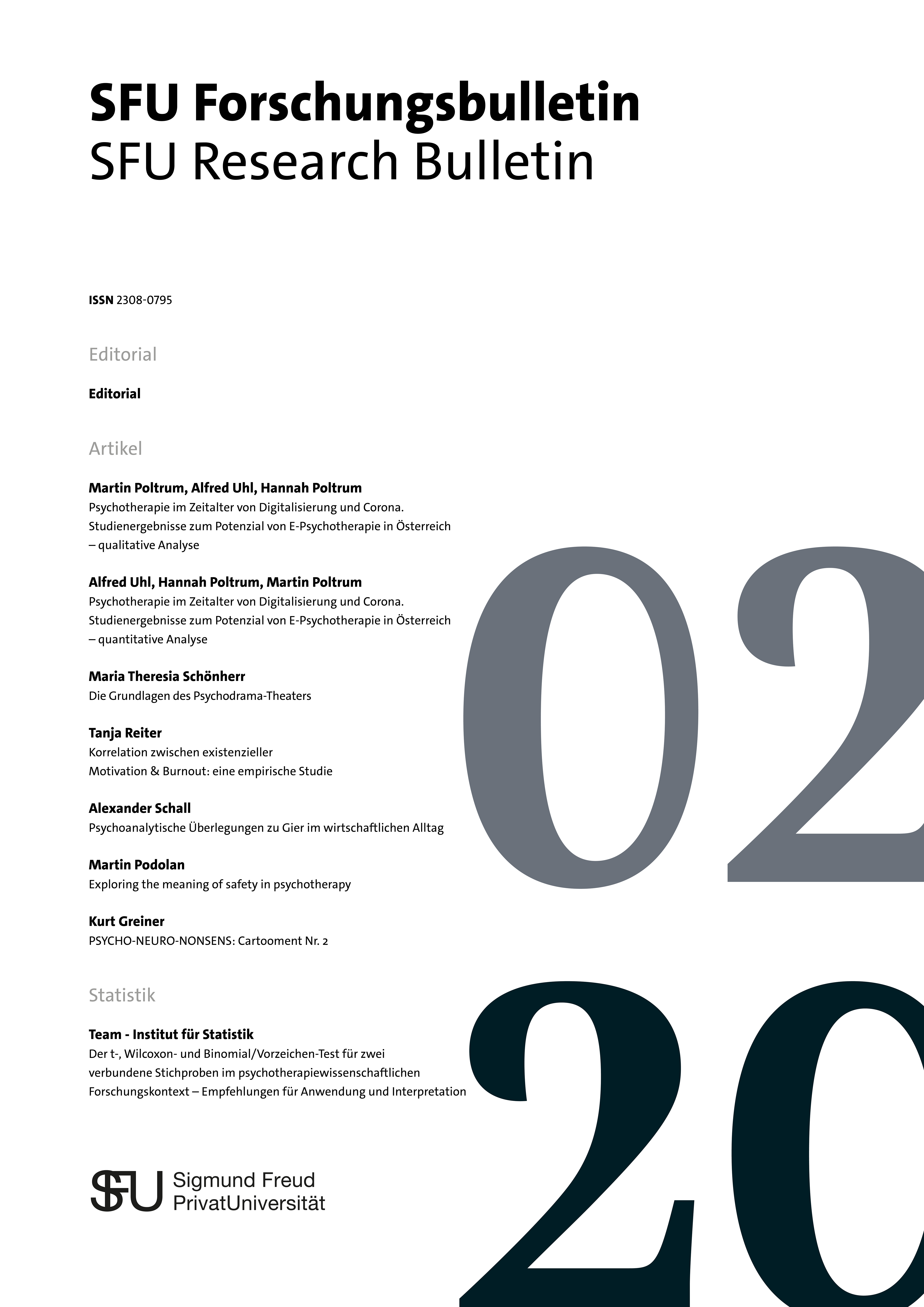t-Test for paired samples, paired sample Wilcoxon sign rank test and the paired sample sign test in psychotherapy science
Recommendations for application and interpretation
DOI:
https://doi.org/10.15135/2020.8.2.128-146Abstract
In this first contribution to the Statistics series in psychotherapy science, the application use of the t-Test for paired samples, paired sample Wilcoxon sign rank test and the paired sample sign test is presented in the sense of a best practice approach. In addition (1) to recommendations for the optimal choice of procedure, (2) the use of effect sizes, (3) the designation of relevant results and (4) report conventions for the presentation of results, (5) the problem of reliable statistical decision making in the research context of psychotherapy science is addressed and therefore, (6) suggestions for dealing with this potential problem are identified.
References
Cohen, J. (1988). Statistical power analysis for the behavioral sciences (2. Aufl.). Hillsdale, N.J: L. Erlbaum Associates.
Beck, A.T., Steer, R.A., & Brown, G.K. (1996). Beck Depression Inventory (2. Aufl.). San Antonio: The Psychological Corporation.
Bortz, J. (2006). Statistik: Für Human-und Sozialwissenschaftler. Heidelberg: Springer Medizin.
Bortz, J., & Döring, N. (2016). Forschungsmethoden und Evaluation in den Sozial- und Humanwissenschaften (5. Aufl.). Berlin: Springer.
Bortz, J., & Schuster, C. (2010). Statistik für Human- und Sozialwissenschaftler (7. Aufl.). Berlin: Springer.
Fritz, O. F., Morris, P. E., & Richler, J. J. (2012). Effect Size Estimates: Current Use, Calculations, and Interpretation. Journal of Experimental Psychology, 141 (1), 2–18.
Grawe, K. (2005). (Wie) kann Psychotherapie durch empirische Validierung wirksamer werden? Psychotherapeutenjournal, 4(1), 4‒11.
Grawe, K. (1992). Psychotherapieforschung zu Beginn der neunziger Jahre [Psychotherapy research at the beginning of the nineties]. Psychologische Rundschau, 43(3), 132–162.
Jones, S. R., Carley, S., & Harrison, M. (2003). An introduction to power and sample size estimation. Emergency Medicine Journal, 20, 453‒458.
Krzywinski, M., & Altman, N. (2013). Power and sample size. Nature Methods, 10, 1139‒1140.
Kühner, C., Bürger, C., Keller, F., & Hautzinger, M. (2007). Reliabilität und Validität des revidierten Beck-Depressionsinventars (BDI-II). Befunde aus deutschsprachigen Stichproben. Der Nervenarzt, 78, 651‒656.
Messer, M., & Schneider, G. (2019). Statistik. Theorie und Praxis im Dialog. Berlin: Springer Spektrum.
Seistock, D., Bunina, A., & Aden, J. (2020). Der t-, Welch-und U-Test im psychotherapiewissenschaftlichen Forschungskontext. Empfehlungen für Anwendung und Interpretation. SFU Forschungsbulletin, 8(1), 87‒105.
Spinhoven, P., Klein, N., Kennis, M., Cramer, A. O., Siegle, G., Cuijpers, P., ... & Bockting, C. L. (2018). The effects of cognitive-behavior therapy for depression on repetitive negative thinking: a meta-analysis. Behaviour research and therapy, 106, 71‒85.
Wilcoxon, F. (1945). Individual Comparisons by Ranking Methods. Biometrics Bulletin, 1, 80–83.
Wilcoxon, F. (1947). Probability Tables for Individual Comparisons by Ranking Methods. Biometrics, 3(3), 119‒122.
Wilcox, R. (2012). Chapter 5 - Comparing Two Groups. In R. Wilcox (Hrsg.), Statistical Modelling and Decision Science. Introduction to Robust Estimation and Hypothesis Testing (S.137‒213) (Third Edition). San Diego: Academic Press.
Downloads
Published
Versions
- 2020-12-23 (3)
- 2020-12-23 (2)
- 2020-12-23 (1)
Issue
Section
License
The reproduction of articles published in any form is allowed under the condition that the citation is comprehensive. Prints in other publication media or public media require the written consent of the editor and can be requested under: forschung@sfu.ac.at
